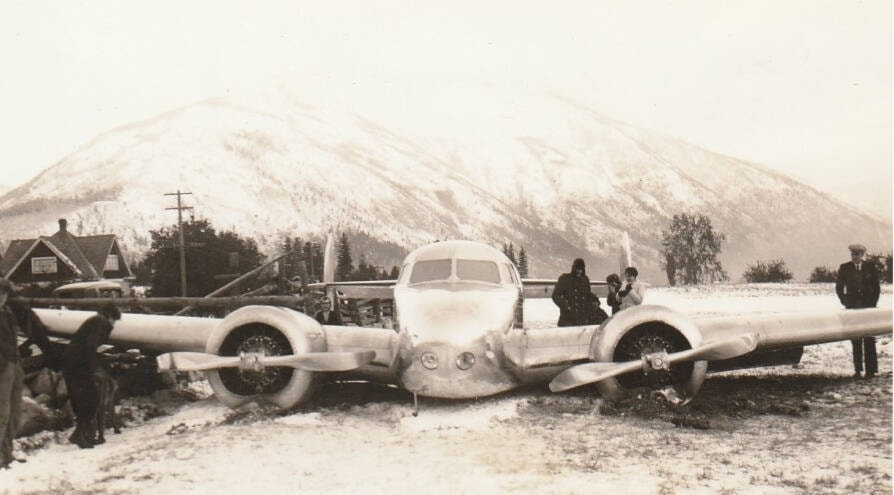Submitted
At about 10 p.m. on October 30, 1935, an airliner came in low over Nelson. It had lost its way in dense fog, far off its course from Billings, Montana to Spokane, Washington, and it was low on fuel.
The plane was a Northwest Airlines twin engine 10-passenger Lockheed Electra. Northwest Airlines in 1935 was advertising flights from Chicago to Seattle, even at night. But due to the atmospheric conditions the radio only produced static, and the beam control had failed. Pilot Frank C. Judd, seeing the big flashing neon “DAILY NEWS” sign on top of the Nelson Daily News building on Baker Street, thought he might be over Wallace, Idaho.
Pilot Judd turned on his landing lights, found a farmer’s field just up the hill in Rosemont (site of today’s Selkirk College), and made a wheels-up pancake landing - a belly landing with the landing gear left up. Although he had never made this type of emergency landing before, he executed it masterfully with no injuries to his five passengers, to his co-pilot, or himself.
They were all surprised to discover they were in Canada. The passengers were cleared by the Department of Transport and Canada Customs and transferred to Spokane by train. Aircraft mechanics and parts arrived from Spokane to repair the plane.
These 86-year- old photos by Henry Stevenson and Hugh Armstrong show in remarkable detail how the plane was removed from the farmer’s field and trucked away to a landing site down on the flats. They are included here with the kind permission of Henry’s son Gerry Stevenson. Henry was a pilot himself and he had practically built the Nelson airstrip with all of his family working on it, raking and throwing stones off the runway.
The first step to removing the plane was to build solid framing to lift the plane to repair the undercarriage and other scrapes and dents. It was set onto a flatbed truck trailer with the wings, propellers and engine cowlings removed, leaving the entire tail section to hang off the back of the trailer.
The plane fuselage was trucked down to the CPR flats where new engines and propellers were installed. The flats had about 650 feet of sand without trees or big stones, just long enough to get the plane airborne again. Just two weeks after the emergency landing, they ran up the new engines, tested everything, and on November 15th put in 25 gallons of fuel. It was just enough to fly the aircraft to Trail where the C M & S Co had built a 3,000 foot long airstrip. Upon being fully refueled in Trail the plane was flown to Spokane, and after more repairs, it was back in service with Northwest Airlines.
When Trans Canada Airlines started operations in 1937 they used the same Lockheed Electras to fly from Seattle to Vancouver. Amelia Earhart had flown one in her ill-fated attempt to fly around the world. Until twin engine Douglas DC-3s became popular a few years later, flying could be hazardous, and pilots had to be prepared to set down in fields between airports. That is undoubtedly the reason Frank Judd was so skilled to be able to land in the dark in Rosemont, and turning uphill likely helped to slow the plane to make a safer landing.
Many thanks to Gerry Stevenson for information and photos used in this story, and for tipping us off to Henry’s firsthand account of the 1935 landing in “Aviation in the West Kootenay”, British Columbia Historical News (vol. 27, no. 2, 1994):
Thanks also to Greg Nesteroff for his recent article on the landing in British Columbia History (Winter 2021).
Read about Frank C. Judd’s extraordinary wartime flying career in Alaska, the Aleutians and China, and postwar in the Pacific:
